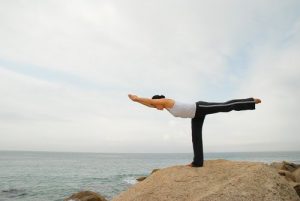The origin of walking meditation belongs to Buddhism and it is a practice for mindfulness. This practice has various potential benefits and can assist you in feeling grounded, calm, and serene. It works towards developing awareness around you like your surroundings, thoughts, and the human body.
Basically, walking meditation requires you to walk at a slow pace. The walking pattern can be circular or walking in a straight line, back and forth, or in a labyrinth. To name a few examples of this practice, they would be:
- Theravada
- Kinhin
- Vipassana
You can either simply stroll around with your mindful for some time or you can apply techniques like dividing each step into 6 parts. You can also check your breath count during walking or repeat a mantra.
Increase blood flow:

Walking meditation is regularly utilized by individuals who sit for extensive stretches. The walking practice assists with jump-starting the blood system, particularly to the legs. It assists in easing the feeling of laziness or dormancy.
Mindful walking is additionally an incredible method to help blood flow and raise your vitality levels in case you’re accomplishing seated work for longer periods.
Improve Digestion:

Walking after you are done eating is a phenomenal method to support processing, particularly in case you’re feeling overwhelmed or full.
Movement of the body encourages food to travel through your digestive tract and can likewise forestall clogging or constipation.
Lowers anxiety:

If you are in a situation where anxiety is taking over your life, you may think that it’s valuable to do a situated meditation practice previously or after you are done with your work out.
A recent report on youthful grown-ups indicated that walking is increasingly successful in decreasing the side effects of anxiety when joined with meditation.
The members who demonstrated the most huge changes in their nervousness levels either meditated performed meditation before walking or strolled before performing meditation. The benchmark group, alongside individuals who just strolled, didn’t appear as incredible of upgrades. Every meditation or walking period was for 10 minutes.
Maintains levels and circulation of blood sugar:

A little 2016 investigation presumed that a Buddhist-based walking meditation practice positively affected glucose levels and circulation in individuals with type 2 diabetes.
Individuals rehearsed mindful or customary walking for 30 minutes, 3 times each week for 12 weeks. The gathering that did the Buddhist walking practice indicated more improvement than the gathering who did conventional walking.
Eliminates depression:

It’s critical to remain active, particularly as you age. Standard exercise assists with boosting wellness levels and works towards improving mood — the two of which are in danger of declining in older grown-ups.
As per a little 2014 examination, much older individuals had fewer manifestations of depression after performing Buddhist meditations through walking 3 times each week for 12 weeks. They additionally work on their blood pressure and practical wellness levels, which can be accomplished through walking.
Improves prosperity:

Whenever the situation allows, go for a stroll in nature, similar to a park, or spot with trees, garden, which may improve your general sentiments of well-being and assist you with feeling progressively balanced.
The act of forest bathing is well known in Japan for its masters like relaxation and upgraded cerebrum movement.
As per a recent report, individuals who strolled for 15 minutes in a bamboo woods demonstrated upgrades to their disposition, nervousness levels, and blood circulation.
Reduces sleep deprivation:

Exercising extremely is not necessary to utilize pros of activity. Research from 2019 indicated that normal moderate exercise positively affects rest quality.
Walking may assist with improving flexibility and diminish muscle pressure so you feel better genuinely.
In fact, you will be required to decrease your stressed and nervous feeling, regardless of the possibility that you will be walking at the start of the day. Those advantages will leave you with a calm, focused head, so you’re able to float and relax comfortably at night.
Makes exercise entertaining:

Consolidating a mindfulness angle into your wellness routine may make practice increasingly pleasant. Analysts in a small 2018 research reliable Source stated that entities who tuned in to a treatment video and then at the same time enjoying a 10-minute run on a treadmill find the activity steadily appealing. We were trained to perceive their bodily stimuli in a non-judgmental way. This focuses on the probability that mindfulness may motivate interfacing with practice in an alternate manner.
Creativeness:

Mindfulness execution may bring you greater clearness and focus on how your thought process works, which thus, can invigorate innovativeness.
Research from 2015 focuses on the connection between mindfulness and innovation. More investigations are required that analyze explicit parts of innovativeness comparable to mindfulness.
Meanwhile, you can investigate how practicing mindfulness improves your critical thinking abilities or the development of new thoughts.
Improves balance:

An investigation from 2019 on older ladies recommends that walking meditation can energize better equalization just as lower as coordination and awareness of ankle.
The training includes familiarity with leg and lower leg developments while walking gradually.
TIPS:
1. Educate yourself about current second
To remain mindful of every second is a tendency that holds away several effort to create.
Bring your mind to the present second as soon as possible as you’ve been walking every time of the day. Concentrate on the vibrations that accompany you, your breath, or other significant sensations. Tweak in your imaginings and observe and go astoundingly.
Perceive how the training fluctuates when you’re walking to a goal in a surge as opposed to walking gradually.
2. Perform seated meditation as well
Walking meditation is regularly utilized related to seated meditation. So you may think that it merits learning seated meditation just as walking meditation.
Situated and walking meditation tips to attempt:
Taking a 5-to 10-minute meditation session accompanied by walking exercise, or the other way around.
Note the variations between the two methods and determine what kind you prefer and why.
You will create the duration of each time as you progress.
3. Take it easy
Frequently, as our mind runs fast, we always run in a hurry. Hinder the speed for a few moments in any case, when you’re running out of time.
Consider the possibility that you will have some interference when you tap into your body and air. Inhale at a gentle, slow rhythm.
Stroll within the time you’ve got, no matter how short.
4. Remains liable
Examine your preparation and goals with a mentor, advisor or partner. Keep in touch regularly to test whether you’ve picked up any pieces of information about how you’re going forward. You will discuss whether to expand your preparation together.

